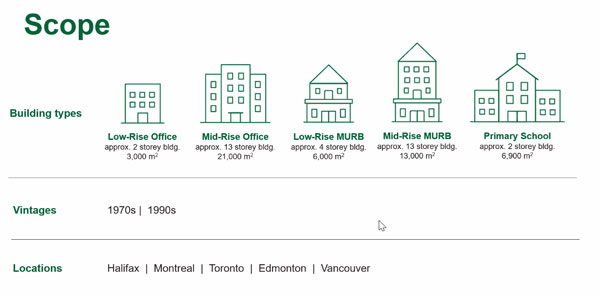The Canada Green Building Council (CaGBC) has released a new report intended to take deep carbon retrofits of Canada’s large buildings further beyond the discussion stage, delivering the research and strategies needed to achieve broad market readiness.
The CaGBC hosted a webinar and panel discussion recently to release the report, with Mona Fortier, president of the Treasury Board of Canada, on hand to declare, “This is the moment for bolder climate action.”
The report is titled Decarbonizing Canada’s Large Buildings: A Pathway Forward.
“This study was geared towards helping equip Canadian building owners and policymakers with tools and information to scale up and accelerate deep carbon retrofits,” states the report, which was prepared by RDH Building Science in partnership with Dunsky Energy Consulting.
CaGBC vice-president Mark Hutchinson hosted presenters Patricia Lightburn, senior consultant with Dunsky, and Steve Kemp, principal with RDH, to outline the report’s major findings.

“We’ve shown we can reduce fossil fuel use by at least 93 per cent and often 100 per cent,” Hutchinson said.
“There are technologies that are readily available today or, as Steve said, perhaps imminently ready.
“When you think about that, that’s really incredible. It’s a huge opportunity for our industry to take action on climate change, really show leadership, spur new markets, new technologies and make Canada a leader.”
To reach its 2030 and 2050 climate commitments, the report states, Canada will need strengthened regulations and policies, major investments, innovative financing structures and building-system advances, as well as a focus on energy-grid optimization and a steadily increasing carbon price.
Technical innovation must continue to ramp up, building owners need to address the research and “do it now,” and governments must “step in and step up,” the report says.
The time for voluntary measures has passed and governments must strengthen policy tools, including mandatory building performance requirements and enabling the right procurement pathways.
The research team studied 50 different building archetypes from the 1970s and the 1990s to evaluate deep carbon retrofit opportunities. Building types included office, multi-unit residential, and primary school, low-rise and midrise, in five regions — Halifax, Montreal, Toronto, Edmonton and Vancouver.
“It really makes the most sense to consider deep carbon retrofits when you’re already investing in the building,” said Kemp. “Buildings from the 1970s are likely to be considering a building envelope renewal sometime soon. The assumption was that a building from the 1990s is likely to be looking for significant improvements in mechanical systems.”
The results were uneven, but the research determined there is significant potential for energy-cost savings in almost all buildings, and that deep carbon retrofits are viable and cost-efficient right now for many low- and midrise office archetypes as well as a few MURBs and primary schools.
Office buildings are the “low-hanging fruit,” the report says.
“Nearly all office building archetypes can reach net-zero carbon operations, while at the same time achieving a positive net present value (NPV),” the report states. “This suggests that deep carbon retrofits make sense for these buildings today, especially for the 1970s archetypes, which included enclosure upgrades.”
Hutchinson urged, “We need to commit to developing transition plans for each and every building, outlining how each asset is going to decarbonize over time.”
The report outlined barriers to adoption in several categories, with economic challenges among others addressed by Lightburn in her presentation.

“When we look at the return on investment compared to the hassle factor, that can definitely be a barrier for a lot of building owners,” she stated as an example. “There’s also a split incentive challenge where potentially the benefits of the deep carbon retrofit don’t necessarily accrue to the party that’s making the investment.
“We also see performance skepticism. Undertaking retrofits of this depth is relatively new in the market, there’s not a lot of good data, maybe the technology is new. So there’s definitely potentially some hesitancy there.”
Among a broad set of recommendations for all parties to consider, owners were told to consider the need to expand the use of innovative approaches for project development, such as no up-front capital payments, off-balance-sheet debt treatment, owner-tenant shared costs and benefits, and reduced project risk through performance guarantees.
Follow the author on Twitter @DonWall_DCN.










Recent Comments
comments for this post are closed